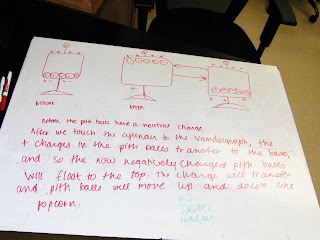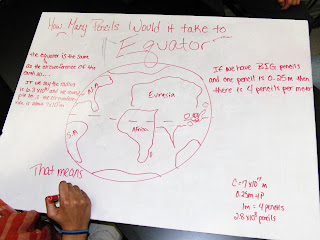If you're not familiar with it, here's the setup (image from www.winsco.com):
The top plate is put in contact with a Van de Graaff generator, and the conductive pith balls are resting on the bottom plate. After that?
Let's warm up first, just like my kids did last week. They broke into groups and each tried to come to agreement on one of the conceptual questions from the text (Giancoli) that I had given them for homework. In the past, I have given these short shrift, but they can be a valuable part of your teaching arsenal, if you let them be. I do clicker questions and conceptual ranking tasks in class, but I had always shrugged them off for HW before. Anyway, this warmup worked really well for one section, and really well for two groups in the next section, but the other groups hadn't done their homework, and... well, you know how well that goes.
The questions (paraphrased) and the whiteboard solutions:
- If a plastic ruler is rubbed with cloth, it can pick up small pieces of paper. Explain why, and why this doesn't work as well on a humid day.
- What balances the repulsive force between the leaves of a charged electroscope?
- Explain why clothes that have just come out of the dryer can sometimes stick to you.
- When a charged plastic ruler picks up small pieces of paper, occasionally one will stick to the ruler and then quickly jump away. Why?
The honors classes haven't done as many reasoning chains, and the results are certainly mixed here. There are all the classics: the insufficiently justified, the over-written, the under-written, etc. Some of these are about communication and learning what's really telling the story, and some represent holes in the conceptual understanding ("But I know the answer!" We all know that having the answer doesn't necessarily mean having the understanding. They haven't all gotten the message, but we're getting there.)
The chains that we did last class and the conceptual homework have, however, delivered far greater understanding than what I've done in the past. All of that demonstration, lecture, etc. gave them the sense that they knew what was going on, but... this year, they're so much stronger with their conceptual understanding.
The difference really became apparent when we went to Volta's hail. I laid out the scenario: the materials that the apparatus is made from, what I'm going to do, etc., but did not demonstrate and did not tell them what would happen or indulge their questions. Get in groups, get on that whiteboard, and figure it out. This part of the cycle I've done before (at least two years). It's always a colossal bust. Almost no groups figure out the complex set of things that are going to happen.
This year, though... all of the groups eventually "got it," only about half went significantly down a blind alley (and they only needed a small prompting question from me to get them back on track), and they really discussed the concepts like folks that knew what they were talking about... ...because they did!
Here are a few of their whiteboards. It was great seeing them move from their gut reactions (usually just that the pith balls would move up to the top plate) on to making a complete and correct prediction. It's especially awesome that their understanding and reasoning process was able to overcome their initial guesses without any intervention from me at all!
These aren't bad at all, and I think that most of the omissions here are communication-oriented rather than about gaps in understanding. Here's a fuller chain:
I will, though, give a video of the demo in action. If you don't use it in class, I'd consider it, because it's really slick and is one of the few really active electrostatics demos.














































